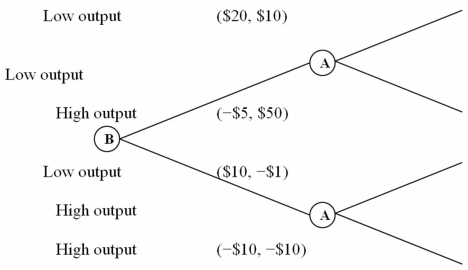Using the following sequential-move production game, determine whether player B has a first-mover advantage and identify the strategy that leads to that advantage: 
A) Player B has a first-mover advantage. The equilibrium strategies leading to an advantage are {(low output) ; (if low output, high output) , (if high output, high output) }.
B) Player B has a first-mover advantage. The equilibrium strategies leading to an advantage are {(low output) ; (if low output, high output) , (if high output, low output) }.
C) Player B has a first-mover advantage. The equilibrium strategies leading to an advantage are {(high output) ; (if low output, high output) , (if high output, low output) }.
D) Player B does not have a first-mover advantage in the game.
Correct Answer:
Verified
Q21: Limit pricing is:
A) a strategy whereby a
Q29: Suppose the inverse market demand is given
Q37: Which of the following is an INCORRECT
Q40: If one more user is added to
Q41: A bottleneck is a:
A) positive externality resulting
Q46: Refer to the following payoff matrix:
Q47: Consider a two-way network with 1,000 users.Adding
Q48: Suppose the inverse market demand is given
Q50: Suppose the inverse market demand is given
Q57: Suppose that Microsoft and Google compete in
Unlock this Answer For Free Now!
View this answer and more for free by performing one of the following actions

Scan the QR code to install the App and get 2 free unlocks

Unlock quizzes for free by uploading documents